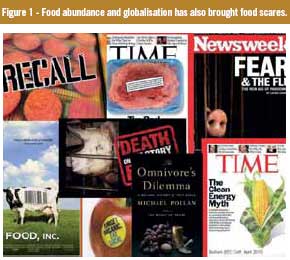Food and feed safety – A joint responsibility

It is apparent that there is a clear responsibility in the food chain for all parties involved regarding food and feed safety. This responsibility is best addressed jointly and not in isolation. Reliable suppliers are essential to guarantee safety and traceability in the feed to fork. Transparency and communication is of paramount importance in getting ‘the message’ to the final consumer in a clear and concise format. In other words, collaboration is the ‘key’ word to succeed under current conditions that require a high degree of safety for the foods we all consume daily.
Modern agriculture and globalisation have brought about an unprecedented abundance of food and freedom from hunger for many developed and developing countries around the world. In exchange, however, we have been exposed to several food related scares on a scale that transcends traditional frontiers. Names like ‘mad cow’ disease, salmonellosis, melamine and dioxin come easily to mind and require no further elucidation (Figure 1). The bottom line is that consumers of agricultural products, and especially consumers of animal-derived products, have been scared too many times giving voice to those who want to restrict and perhaps over-regulate animal agriculture to the point where it is no longer profitable to operate in developed countries.
The feed industry has not been immune to these kind of problems as similar stories frequently reach the media. We only need to mention the case (March 19, 2010), where German authorities informed the feed industry that a consignment of over three thousand kilograms of vitamin A of Chinese origin was found to contain high levels of dioxin. And not to mention the most recent case in January where dioxin entered the food chain through the use of dioxin contaminated technical fats in compound feed that were not meant to be used in animal feed.
Traceability
In line with the problems caused in the food chain, the feed industry is frequently faced with similar embarrassing problems that hurt its public image as an integral part of the human food chain by sourcing ingredients through low-cost suppliers. And although this is not the only issue, it definitely is one of the most important. Clearly, quality and very low cost cannot be found on the same spot! We can again refer to another recent example, when the recall of thousands of duck eggs from Beijing caused a stir in the media – apparently, local farmers had used a carcinogenic colorant (Sudan Red IV) to give yolks a more appealing colour.
The true cost of safety and traceability is usually difficult to estimate as it involves more than a drop in consumer demand. For example, a company might experience a dramatic drop in its share value (if it is in the stock exchange market) due to a product recall caused by a contaminated ingredient. Such examples are abound in the media.When it comes to micro-ingredients, such as vitamins, trace minerals, and most additives, such as egg colorants to use the example above, the major issue regarding safety is traceability in the animal feed. As these ingredients are used in minute amounts, the presence of any contaminant is not only expensive (in some cases analytical procedures are extremely costly), but also quite difficult to identify in routine laboratory analyses. The same issue of traceability is faced by most feed manufacturers. For example, a typical feed formula that contains 35 ingredients (counting all micro-ingredients), with a minimum of 3 suppliers per ingredient, provides a nightmare to the quality assurance department as over 100 suppliers are usually involved (Figure 2). Even if they were all to be monitored for quality purposes, the cost would be prohibiting. Thus, at the end, it is mostly about trust.
Regaining trust
It is clear to all involved in the feed industry that addressing human food scares should not be the responsibility of any single group. An informal consensus has been reached where all parties are expected to work hard together to regain consumer confidence, starting from the farmer, the nutrition supplier, the slaughterhouse, the meat processor, and ending at the vendors display case.We all are ultimately responsible.
First, we must identify what it is the consumer really wants. Definitely price is an issue, and perhaps a misunderstanding of this attitude is the root problem of many food scares, but given a choice, consumers have made a clear preference: they prefer what they perceive as safer food over price by a large margin. Of course, food safety can be assigned many attributes, but in plain words consumers don’t want the food they eat to be damaging their health. And, according to a recent EFSA study, most Europeans actually don’t trust the food they eat on a daily basis.Second, in order to succeed in regaining consumer confidence in animal agriculture, we must establish a partnership that involves all parts of the chain. Here, nutrition suppliers can play a leading role as they can lay the foundations of quality for both animal producers and the feed industry. Quality, however, is not something that can be achieved overnight. It takes a long-term dedication, along with a strong philosophy to maintain this dedication. Here, working with established names that provide safety, traceability, and a high level of quality assurance is the key to success.Third, it is not sufficient for the animal agriculture sector to ‘clean up’ its act, as we have been told numerous times, and provide a high quality product that is safe, wholesome, and at a reasonable price. We must also ‘advertise’ our good efforts, our traceability, our quality assurance programs, and our dedication to quality in the long-term. Consumers need to know we have been listening to their concerns and we are doing our part.
Selling quality
Selling any product on price is relatively easy because consumers can easily compare two ‘apparently similar’ products and make a decision based on a numerical difference. Selling any product based on its merits, one of which is quality as we have defined it above, is actually quite difficult. It takes not only a long process to produce a quality product, but the marketing of it (getting consumers to know about its quality) requires considerable effort. And this effort means spending time and money, which of course, come at a premium.
To this end, partnerships are perhaps the best possible solution. Here’s a very simplified example. If a baker sells bread based on organic wheat, he markets his product not on the merits of his own baking efforts, but on the efforts of the wheat producer. Now, if the wheat was also processed in an old-fashioned stone-mill and this is advertised on the product’s package, he also takes advantage of this extra feature. Actually, it is not even required for the bread to be of ‘gourmet’ quality, but it would be really helpful if the bakery made it known his bakery adheres to the highest public health standards.
The same approach is of course possible in the animal feed industry, but for a number of reasons it has not been so widespread. One of the reasons is perhaps the fact of keeping ‘secret’ the source of certain ingredients. In today’s world, however, this can only enhance the suspicion of consumers. In fact, regulations in most developed and developing countries require different degrees of openness when it comes to raw material sourcing.
Some practical experience
DSM, as with many other food and feed companies worldwide, have been close followers of the quality principle since the inception of our company. Although all suppliers must make sure customers receive products of the highest possible standards, we have now made this fact a transparent and straightforward commitment to the feed, food industry, and even to consumers. In this way, reliable suppliers will be offering to customers – the feed manufacturers – the full value of our products.
In brief, much effort has been made to help customers capitalise on the high-quality image of products and they have not failed to reap these new benefits. Here, we will share some success cases to illustrate the DSM concept of food chain partnership.
Case 1 – Feed Additives
Leading companies in the business of additives must adhere to the strictest quality standards possible if they are to retain their leading position in a highly competitive market. In other words, it is long known that you can never buy back your reputation with the money you save on non-reliable ingredients (Figure 3). As such, DSM Nutritional Products have always adhered to the highest quality standards as part of our overall quality assurance program. As part of our food-chain partnership program, we have developed a new Quality Seal (Figure 4) that is applied to all of our food and feed ingredients (see also www.qualityforlife.com, where the DSM philosophy on quality products is explained in detail). With this combined approach (quality products and strong advertisement of quality merits) it is believed we have made the first step in informing our consumers about our part in ensuring food safety. In fact, the 2009 Frost & Sullivan Award for “Global Excellence in Quality in Infant Nutrition” only verified DSM’s long-term efforts on this front.
Case 2 – Optimum Vitamin Nutrition (OVN)
DSM has long advocated the concept of optimum vitamin nutrition. This is a level of nutrition that ensures maximal animal performance, welfare, and health, and maximal return on investment for the animal producer. As expected, this has created a very positive image for this approach to consumers. Indeed, in a recent study, over 60% of consumers believed this is the right way to go in feeding animals. This is definitely something we would like to make widely known. We have also made considerable efforts to place our OVN-concept in mainstream media as part of explaining to the public our efforts towards a safe food supply.
This has been met with great interest and we believe it has raised the awareness of the public in the efforts of the whole animal industry to answer legitimate concerns of food safety.
Note: *These people at DSM Nutritional Products also worked on this article: Dawn Bracy, Mar Arteaga, Chen Luo, Christos Antipatis, Federico Etcheverry.











